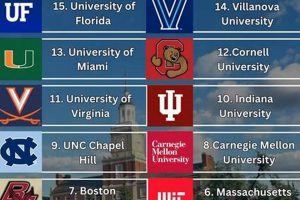High-quality online programs in landscape architecture offer students the flexibility to pursue advanced education while maintaining professional or personal commitments. These programs typically blend asynchronous coursework with live virtual sessions, providing opportunities for interaction with faculty and peers. A robust online curriculum often includes digital design tools, virtual site visits, and online portfolio development, mirroring the essential components of traditional programs. Students seeking such programs should carefully evaluate accreditation, faculty expertise, and available resources.
The accessibility afforded by distance learning has expanded opportunities for individuals seeking careers in landscape architecture. Professionals can enhance their skills and knowledge without career disruption, while those in remote areas gain access to reputable programs previously unavailable. Historically, landscape architecture education relied heavily on in-person studio experiences. However, advancements in online learning technologies have facilitated the development of robust virtual environments that effectively support design education and collaboration.
This exploration of top-tier online landscape architecture programs will delve into factors such as curriculum rigor, faculty credentials, program costs, and career support services. Further examination will include the advantages and disadvantages of online learning in this field, along with insights into the licensure requirements for practicing landscape architecture.
Tips for Selecting an Online Landscape Architecture Program
Choosing the right online program requires careful consideration of individual circumstances and career goals. The following tips offer guidance in navigating the selection process.
Tip 1: Verify Accreditation: Ensure the program holds accreditation from a recognized body, such as the Landscape Architectural Accreditation Board (LAAB). This ensures the program meets established quality standards and may be required for professional licensure.
Tip 2: Evaluate Faculty Expertise: Research the faculty’s credentials, experience, and areas of specialization. Look for instructors with professional practice experience and a strong record of teaching and research.
Tip 3: Assess Curriculum Rigor: Examine the program’s curriculum to ensure it covers essential topics such as site analysis, design principles, plant materials, and construction techniques. Look for programs incorporating current technologies and sustainable practices.
Tip 4: Consider Program Format and Flexibility: Determine whether the program’s format aligns with individual learning styles and scheduling needs. Asynchronous programs offer greater flexibility, while synchronous programs provide more real-time interaction.
Tip 5: Explore Technological Resources and Support: Investigate the program’s technological resources, including software access, online library resources, and technical support. Access to digital design tools is essential for online landscape architecture education.
Tip 6: Investigate Career Services and Alumni Network: Inquire about career services offered, such as portfolio development assistance, internship opportunities, and job placement support. A strong alumni network can also provide valuable networking opportunities.
Tip 7: Compare Program Costs and Financial Aid Options: Carefully evaluate the total program costs, including tuition, fees, and technology requirements. Explore available financial aid options, such as scholarships, grants, and loan programs.
By considering these factors, prospective students can make informed decisions that align with their educational and professional aspirations. Selecting a program that provides a comprehensive education, relevant skills, and career support is vital for long-term success in the field of landscape architecture.
These considerations provide a framework for evaluating potential programs and selecting the best fit for individual career objectives. The next section will explore specific examples of highly regarded online landscape architecture programs.
1. Accreditation
Accreditation serves as a crucial benchmark for quality in online landscape architecture education. It signifies that a program meets established professional standards and provides students with a credible and valuable learning experience. For prospective students seeking the best online landscape architecture schools, accreditation is a non-negotiable factor.
- Programmatic Standards
Accreditation bodies, such as the Landscape Architectural Accreditation Board (LAAB), evaluate programs based on a comprehensive set of standards. These standards encompass curriculum content, faculty qualifications, student support services, and institutional resources. Programs must demonstrate adherence to these standards to earn and maintain accreditation. For example, a LAAB-accredited program ensures curriculum alignment with professional practice and adequate faculty expertise.
- Professional Licensure
Accreditation plays a critical role in professional licensure. In many jurisdictions, graduation from a LAAB-accredited program is a prerequisite for taking the Landscape Architect Registration Examination (LARE). Therefore, choosing an accredited program is essential for individuals seeking professional licensure and career advancement. For example, students planning to pursue licensure in states requiring LAAB-accreditation must ensure their chosen online program meets this requirement.
- Quality Assurance
Accreditation provides quality assurance for students and employers. It signifies that the program undergoes regular reviews and meets established benchmarks for educational excellence. This assures students of a high-quality education and signals to employers that graduates possess the requisite knowledge and skills. Choosing an accredited program provides confidence in the program’s commitment to maintaining educational standards.
- Credibility and Recognition
Accreditation enhances the credibility and recognition of online landscape architecture programs. It differentiates programs that meet rigorous standards from those that do not. This recognition benefits graduates when seeking employment and pursuing career advancement opportunities. A degree from an accredited institution carries greater weight with employers and professional organizations.
Therefore, accreditation is a critical factor in identifying the best online landscape architecture schools. It not only ensures a quality education but also facilitates professional licensure and career advancement. By prioritizing accredited programs, prospective students invest in their future and position themselves for success in the field of landscape architecture.
2. Faculty Expertise
Faculty expertise stands as a cornerstone of high-quality online landscape architecture education. The knowledge, experience, and pedagogical skills of instructors directly impact student learning outcomes and program reputation. In the context of identifying the best online landscape architecture schools, faculty expertise serves as a critical differentiator.
- Professional Experience
Experienced faculty bring real-world insights and practical knowledge to online classrooms. Their professional practice experience enriches the curriculum and provides students with relevant examples and case studies. For instance, instructors who have led complex landscape architecture projects can offer valuable perspectives on design process, project management, and client interaction. Programs with faculty possessing extensive professional experience enhance the practical relevance of online learning.
- Scholarly Contributions
Faculty engaged in research and scholarship contribute to the advancement of landscape architecture knowledge. Their contributions ensure that online programs remain at the forefront of innovation and best practices. Faculty publications and presentations in areas such as sustainable design, urban ecology, or digital technologies enrich the curriculum and expose students to cutting-edge concepts. Programs with faculty actively contributing to the field offer a more dynamic and intellectually stimulating learning environment.
- Teaching Effectiveness
Effective online teaching requires specialized pedagogical skills. Faculty experienced in online instruction understand how to engage students in virtual environments, facilitate collaborative learning, and provide individualized support. Their ability to adapt teaching methods to the online format and utilize digital tools enhances student learning outcomes. The best online programs prioritize faculty with demonstrated online teaching effectiveness.
- Mentorship and Guidance
Faculty mentorship plays a vital role in student success. Mentors provide guidance on academic and career pathways, offer personalized feedback on student work, and support the development of professional portfolios. Strong mentorship relationships contribute to a supportive online learning community and enhance student career prospects. Programs emphasizing faculty mentorship offer valuable support for online students.
These facets of faculty expertise collectively contribute to the quality and reputation of online landscape architecture programs. Prospective students seeking the best online learning experiences should prioritize programs with faculty demonstrating strong professional experience, scholarly contributions, teaching effectiveness, and mentorship capabilities. This focus on faculty expertise ensures a rich and rewarding educational journey and positions graduates for success in the field of landscape architecture.
3. Curriculum Rigor
Curriculum rigor significantly influences the quality and reputation of online landscape architecture programs. A rigorous curriculum ensures that graduates possess the essential knowledge, skills, and competencies required for professional practice. In the context of identifying the best online landscape architecture schools, curriculum rigor serves as a defining characteristic. A comprehensive curriculum should encompass core areas such as site analysis, design principles, plant materials, construction techniques, and professional practice. For example, a robust program might incorporate advanced coursework in sustainable design, digital technologies, or urban ecology, reflecting current industry trends and preparing students for emerging challenges. Furthermore, a rigorous curriculum should challenge students to develop critical thinking, problem-solving, and design skills through demanding projects and real-world applications. The integration of case studies, simulations, and virtual site visits can enhance the practical relevance of online learning and bridge the gap between theory and practice.
The practical significance of curriculum rigor extends beyond academic preparation. Employers seek graduates who possess not only theoretical knowledge but also the practical skills to contribute effectively to projects from day one. A rigorous curriculum equips students with the competencies required to succeed in diverse professional settings, whether in private firms, public agencies, or non-profit organizations. For instance, graduates of programs emphasizing construction detailing and project management are well-prepared for roles involving site supervision and construction administration. Similarly, programs emphasizing community engagement and participatory design prepare graduates for roles in public sector planning and community development. Therefore, curriculum rigor directly impacts career readiness and long-term professional success.
In summary, curriculum rigor is a crucial component of best online landscape architecture schools. A demanding and comprehensive curriculum ensures that graduates possess the knowledge, skills, and competencies needed to excel in the field. By prioritizing programs with rigorous curricula, prospective students invest in their future and position themselves for rewarding careers in landscape architecture. This focus on rigor benefits not only individual graduates but also the profession as a whole, contributing to a higher standard of practice and innovation in the field.
4. Technological Resources
Technological resources are integral to the success of online landscape architecture programs. Access to advanced software, digital design tools, and robust online learning platforms distinguishes leading programs from less technologically advanced options. The integration of technology enhances the learning experience, prepares students for contemporary professional practice, and expands opportunities for collaboration and innovation.
- Software Proficiency
Proficiency in industry-standard software is essential for landscape architects. Best online programs provide access to and training in software such as AutoCAD, Revit, SketchUp, and Geographic Information Systems (GIS). This access enables students to develop digital design skills, create 3D models, analyze site data, and produce professional-quality drawings and presentations. For example, students might utilize Revit to create detailed construction documents for a green roof project or employ GIS to analyze site hydrology and vegetation patterns. This proficiency translates directly into career readiness, as employers expect graduates to possess advanced software skills.
- Digital Design Tools
Beyond traditional software, access to specialized digital design tools enhances the learning experience. These tools might include virtual reality (VR) and augmented reality (AR) applications, 3D printing technologies, and laser scanning equipment. VR and AR can create immersive design experiences, enabling students to visualize designs in three dimensions and explore virtual site conditions. 3D printing facilitates the creation of physical models and prototypes, while laser scanning enables accurate site surveys and data capture. These tools foster innovation and provide students with hands-on experience with cutting-edge technologies.
- Online Learning Platforms
Robust online learning platforms facilitate effective online instruction and interaction. These platforms provide access to course materials, lectures, assignments, and communication tools. Features such as discussion forums, video conferencing, and online collaboration tools enhance student engagement and foster a sense of community. Effective online learning platforms create seamless and engaging learning experiences, accommodating diverse learning styles and schedules. For example, asynchronous learning platforms allow students to access course materials and complete assignments at their own pace, while synchronous platforms facilitate real-time interaction with faculty and peers through live video sessions.
- Technical Support
Reliable technical support is crucial for online learners. Best online programs offer comprehensive technical assistance to address software issues, troubleshoot online platform problems, and provide guidance on utilizing digital design tools. Prompt and effective technical support minimizes disruptions to the learning process and ensures that students can fully engage with the online environment. Dedicated technical support staff, online tutorials, and FAQs contribute to a positive and productive online learning experience.
These technological resources collectively contribute to the quality and effectiveness of online landscape architecture education. By providing access to cutting-edge technology and robust support systems, best online programs prepare students for the demands of contemporary professional practice and empower them to become innovative leaders in the field. The integration of technology not only enhances the learning experience but also positions graduates for success in a rapidly evolving professional landscape.
5. Career Support
Robust career support services are a hallmark of best online landscape architecture schools. Effective career services bridge the gap between academic preparation and professional practice, equipping graduates with the tools and resources needed to launch successful careers. This support encompasses a range of services, including portfolio development, internship placement, job search assistance, and professional networking opportunities. The presence of comprehensive career support distinguishes leading online programs and significantly impacts graduate career outcomes.
Portfolio development is crucial for showcasing design skills and experience to potential employers. Best online programs offer guidance on creating compelling portfolios that highlight individual strengths and project experience. This guidance might include workshops on portfolio design, individual consultations with faculty or career advisors, and access to online portfolio platforms. For example, a program might offer a dedicated portfolio development course that provides step-by-step instruction on curating project examples, crafting project narratives, and presenting work effectively. Strong portfolios significantly enhance graduates’ competitiveness in the job market.
Internship placements provide valuable practical experience and networking opportunities. Best online programs actively facilitate internship placements with reputable firms, public agencies, and non-profit organizations. These placements allow students to apply their academic knowledge in real-world settings, develop professional skills, and build connections with potential employers. For example, a program might partner with local design firms to offer paid internships to online students during the summer months. These internships often lead to full-time employment opportunities after graduation. Furthermore, internships expose students to diverse project types and work environments, broadening their understanding of the field and informing their career choices.
Job search assistance equips graduates with the skills and strategies needed to navigate the job market effectively. Best online programs offer workshops on resume and cover letter writing, interview preparation, and job search strategies. They may also provide access to online job boards, career fairs, and alumni networks. For example, a program might host virtual career fairs connecting students with potential employers across the country. These resources enable graduates to target their job searches, present themselves professionally, and connect with hiring managers. Effective job search strategies significantly reduce the time it takes for graduates to secure employment after graduation.
Professional networking opportunities connect students with practicing professionals and potential mentors. Best online programs facilitate networking through online forums, virtual events, and alumni networking platforms. These connections provide valuable insights into industry trends, career pathways, and professional practice. For example, a program might host a series of online guest lectures featuring prominent landscape architects discussing their career journeys and offering advice to students. These networking opportunities broaden students’ perspectives, provide valuable career guidance, and facilitate connections that can lead to internships or employment opportunities. Building a strong professional network is essential for long-term career success.
In conclusion, comprehensive career support is a critical component of best online landscape architecture schools. These services play a vital role in preparing graduates for successful careers, bridging the gap between academic learning and professional practice. By prioritizing programs with robust career support, prospective students invest in their future and position themselves for rewarding and impactful careers in the field of landscape architecture.
Frequently Asked Questions
This section addresses common inquiries regarding online landscape architecture education, providing concise and informative responses to facilitate informed decision-making.
Question 1: Are online landscape architecture degrees as respected as traditional degrees?
Accreditation by the Landscape Architectural Accreditation Board (LAAB) ensures online programs meet the same rigorous standards as traditional programs. Employers increasingly recognize the value of accredited online degrees, particularly given the growing demand for flexible learning options.
Question 2: How do online programs address the hands-on nature of landscape architecture?
Online programs utilize various strategies to provide practical experience. These include virtual site visits, digital design tools, collaborative online projects, and opportunities for local fieldwork or independent study related to a student’s geographic location.
Question 3: Is it possible to pursue licensure after completing an online landscape architecture program?
Graduates of LAAB-accredited online programs are eligible to pursue licensure. Meeting specific state requirements, including completing the Landscape Architect Registration Examination (LARE), remains essential.
Question 4: What are the typical admission requirements for online landscape architecture programs?
Admission requirements vary by program but typically include a bachelor’s degree, transcripts, letters of recommendation, and a portfolio demonstrating design aptitude. Some programs may require specific prerequisite coursework.
Question 5: How do online programs facilitate interaction between students and faculty?
Online programs utilize various communication tools, including video conferencing, discussion forums, email, and individual consultations, to facilitate interaction between students and faculty. Live virtual studio sessions and online critiques provide opportunities for real-time feedback and collaboration.
Question 6: What are the advantages of online landscape architecture programs compared to traditional programs?
Online programs offer flexibility, allowing students to balance education with other commitments. Accessibility is another advantage, as online programs eliminate the need for relocation and accommodate students in geographically diverse locations. Furthermore, online programs often incorporate cutting-edge technologies, preparing students for digital design practice.
Careful consideration of these frequently asked questions equips prospective students with essential information for evaluating online landscape architecture programs. A thorough understanding of program formats, accreditation, licensure pathways, and career support services empowers informed decision-making.
The following section will explore specific examples of highly regarded online landscape architecture programs, offering detailed insights into curriculum, faculty, and career outcomes.
Best Online Landscape Architecture Schools
Selecting from the best online landscape architecture schools requires careful evaluation of several key factors. Accreditation ensures adherence to professional standards, impacting licensure and career prospects. Faculty expertise, curriculum rigor, and access to cutting-edge technological resources contribute significantly to the quality of education and career preparedness. Robust career support services, including portfolio development guidance, internship facilitation, and job search assistance, are essential for successful transitions into professional practice. Thorough consideration of these factors empowers informed decision-making, aligning educational pursuits with individual career aspirations.
The evolving landscape of online education presents both opportunities and challenges for aspiring landscape architects. Adaptability, a commitment to lifelong learning, and a proactive approach to professional development are crucial for navigating this evolving field. By embracing technology and leveraging the accessibility of online education, future landscape architects can acquire the knowledge and skills needed to shape sustainable and resilient environments for generations to come. Diligent research and careful program selection are pivotal steps towards a fulfilling and impactful career in landscape architecture.







